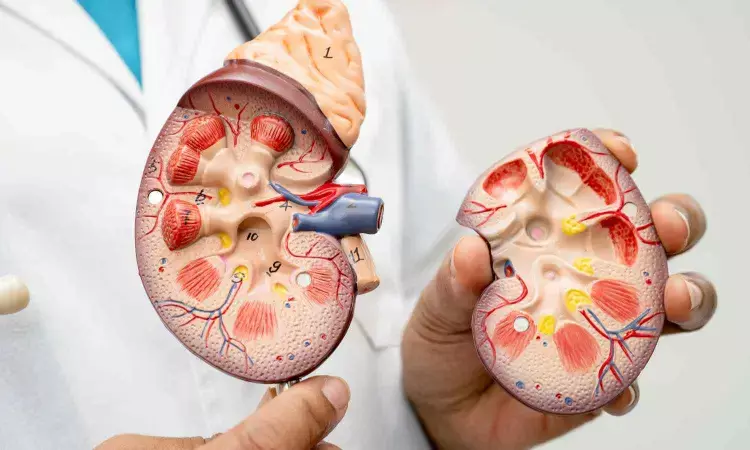- Home
- Medical news & Guidelines
- Anesthesiology
- Cardiology and CTVS
- Critical Care
- Dentistry
- Dermatology
- Diabetes and Endocrinology
- ENT
- Gastroenterology
- Medicine
- Nephrology
- Neurology
- Obstretics-Gynaecology
- Oncology
- Ophthalmology
- Orthopaedics
- Pediatrics-Neonatology
- Psychiatry
- Pulmonology
- Radiology
- Surgery
- Urology
- Laboratory Medicine
- Diet
- Nursing
- Paramedical
- Physiotherapy
- Health news
- Fact Check
- Bone Health Fact Check
- Brain Health Fact Check
- Cancer Related Fact Check
- Child Care Fact Check
- Dental and oral health fact check
- Diabetes and metabolic health fact check
- Diet and Nutrition Fact Check
- Eye and ENT Care Fact Check
- Fitness fact check
- Gut health fact check
- Heart health fact check
- Kidney health fact check
- Medical education fact check
- Men's health fact check
- Respiratory fact check
- Skin and hair care fact check
- Vaccine and Immunization fact check
- Women's health fact check
- AYUSH
- State News
- Andaman and Nicobar Islands
- Andhra Pradesh
- Arunachal Pradesh
- Assam
- Bihar
- Chandigarh
- Chattisgarh
- Dadra and Nagar Haveli
- Daman and Diu
- Delhi
- Goa
- Gujarat
- Haryana
- Himachal Pradesh
- Jammu & Kashmir
- Jharkhand
- Karnataka
- Kerala
- Ladakh
- Lakshadweep
- Madhya Pradesh
- Maharashtra
- Manipur
- Meghalaya
- Mizoram
- Nagaland
- Odisha
- Puducherry
- Punjab
- Rajasthan
- Sikkim
- Tamil Nadu
- Telangana
- Tripura
- Uttar Pradesh
- Uttrakhand
- West Bengal
- Medical Education
- Industry
Position menstrual cups carefully to avoid possible kidney problems, doctors urge

A poorly positioned menstrual cup to capture monthly blood flow may lead to more serious complications than leakage alone, warn doctors in the journal BMJ Case Reports, after treating a young woman with uterohydronephrosis-a swollen kidney caused by blocked urine flow into the bladder.
The use of menstrual cups as a sustainable alternative to other methods of controlling period blood flow is rising, note the report authors. While reported complications are rare, the evidence suggests that pain, vaginal wounds, allergic reactions, leakage, urinary incontinence, dislodgement of intrauterine devices (‘coils’), and infections, are all possible, they add.
The doctors treated a young woman in her early 30s who had noticed blood in her urine and was experiencing intermittent right-sided flank and pelvic pain that had lasted for around 6 months.
Three years earlier, she had had a 9 mm kidney stone removed. And she was using a copper coil for contraception. One or 2 days a month, during the heaviest period blood flow, she used a menstrual cup which she emptied every 2–3 hours.
A scan revealed no signs of kidney stones, but it did show a swollen right kidney and ureter-the tube that carries urine away from the kidneys. It also showed a menstrual cup positioned right next to the opening of the ureter into the bladder (ureteral ostium).
The woman was asked not to use the menstrual cup during her next period and to return for a follow up scan a month later. The scan showed that the swelling had gone down and that urine was draining normally from both kidneys.
The woman’s symptoms had cleared up completely, prompting the report authors to conclude that the cup had obstructed the flow of urine from the right ureter.
When the woman attended for a further check-up six months later, she said that she had only used the menstrual cup occasionally for 3–4 hours at a time during visits to a swimming pool. She hadn’t wanted to use the cup regularly again, for fear of possible complications.
“To our knowledge only a few similar cases have previously been reported. [These] cases were similar to our case,” note the report authors.
“In all cases except one, a follow-up [computed tomography scan] or ultrasound was performed which showed regression of the ureterohydronephrosis. In three cases, the women resumed use of the menstrual cup, and none of them experienced resumption of symptoms (unknown follow-up periods). One of them chose a smaller sized cup,” they write.
Women (and clinicians) need to be better informed about the correct use (and potential complications) of menstrual cups, suggest the report authors.
“When the terminal part of the ureters passes into the bladder, they are in close proximity to the vagina, which can affect urinary drainage from the ureter. Correct positioning, along with choosing the correct cup shape and size, is important to prevent negative effects on the upper urinary tract,” they explain.
“Presently, menstrual cups can be bought and used without clinical advice from a health professional, which emphasises the importance of detailed and clear patient information material,” they add.
Reference:
Prip CM, Jakobsen LKUreterohydronephrosis due to a menstrual cupBMJ Case Reports CP 2025;18:e262035.
Dr Kamal Kant Kohli-MBBS, DTCD- a chest specialist with more than 30 years of practice and a flair for writing clinical articles, Dr Kamal Kant Kohli joined Medical Dialogues as a Chief Editor of Medical News. Besides writing articles, as an editor, he proofreads and verifies all the medical content published on Medical Dialogues including those coming from journals, studies,medical conferences,guidelines etc. Email: drkohli@medicaldialogues.in. Contact no. 011-43720751


